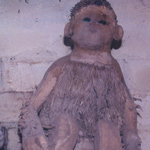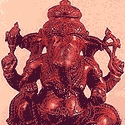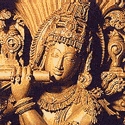Root Carving of Tripura,
Bamboo handicrafts of Agartala are pivoted in the bamboo splitting technique. Splitting of bamboo is recently mechanised at various training centres and common facilities set up by government. The objects very intricately designed and decorated are used in various day to day activities. The products range from screens, false ceilings, wall panels, screens, plaques and planters. The product innovation has lead to a newer bamboo craft known as root carving. The bamboo roots are carved by many artisans in the region as a new project from State Handicrafts Development Corporation. Objects like statues, composite sculptures are now depicted through bamboo root carvings.
Bamboo handicrafts of Agartala are pivoted in the bamboo splitting technique. Splitting of bamboo is recently mechanised at various training centres and common facilities set up by government. The objects very intricately designed and decorated are used in various day to day activities. The products range from screens, false ceilings, wall panels, screens, plaques and planters. The product innovation has lead to a newer bamboo craft known as root carving. The bamboo roots are carved by many artisans in the region as a new project from State Handicrafts Development Corporation. Objects like statues, composite sculptures are now depicted through bamboo root carvings.
Roots and Dead-wood Crafts,
There are some craftspeople in Sri Lanka who make use of roots and deadwood in their natural forms to produce attractive craft creations. The natural shape of the material is not compromised. Dead wood such as roots, trunks, and branches are transformed into life-like animal forms. The key tools required for this craft are a sharp implement like a chisel or knife along with a hammer. The pieces of wood are selected very carefully after observing whether they have the shapes (head, tail, etc.) and characteristics of animals, birds, and reptiles; such pieces are selected and fashioned into suitable forms. Crafts such as these are made popular by way of exhibitions so that awareness builds up and people begin to purchase the products.
There are some craftspeople in Sri Lanka who make use of roots and deadwood in their natural forms to produce attractive craft creations. The natural shape of the material is not compromised. Dead wood such as roots, trunks, and branches are transformed into life-like animal forms. The key tools required for this craft are a sharp implement like a chisel or knife along with a hammer. The pieces of wood are selected very carefully after observing whether they have the shapes (head, tail, etc.) and characteristics of animals, birds, and reptiles; such pieces are selected and fashioned into suitable forms. Crafts such as these are made popular by way of exhibitions so that awareness builds up and people begin to purchase the products.
Rose Wood Carving of Tamil Nadu,
Madurai is famous for rosewood carvings in bold forms with minutely and painstakingly carved details. They are usually made into tables which are outstanding and have motifs that are floral with parrots or panels with epic scenes. Rosewood carving also appears on carved screens, picture frames, easels, jewellery chests and furniture of the heavy English Victorian style such as cabinets, desks, chairs, tables and sideboards and decorated with Hindu and floral motifs.
Madurai is famous for rosewood carvings in bold forms with minutely and painstakingly carved details. They are usually made into tables which are outstanding and have motifs that are floral with parrots or panels with epic scenes. Rosewood carving also appears on carved screens, picture frames, easels, jewellery chests and furniture of the heavy English Victorian style such as cabinets, desks, chairs, tables and sideboards and decorated with Hindu and floral motifs.
Rosewood and other Wood Carving of Kerala,
Wood-carving, especially rose wood carving is found concentrated mainly in Trivandrum and Trichur, with Ernakulam and Cochin being the next most important centres. Isolated carving units are located even in the interior villages. The main products made are rose wood elephants, varying in size from 1 inch to 32 inches, figures of animals like the rhinoceros, tiger, camel, and horse, figures of Buddha and Christ, Kathakali dancers, and men and women in traditional costume. Rose wood paras or measuring drums are made along with nettur boxes. Thrissur is also renowned for its ivory carving; with the ban on ivory these craftsmen transferred their skills to the variety of tropical wood available in the region - primarily white cedar, teak and rosewood. The chief products made today are animal figurines, especially that of the elephant, the beast that predominantly features in the religious practices of the region. The sculptures range from figures that are 10 inches tall to others that are lifesize. The same animal is represented in a number of poses; the realism of the carving, the detailing of the body and the graceful contours, all revealing the proficiency of the craftsmen. In addition to these products targeted largely at the sizeable non-resident Malayali community, the craftsmen also create elaborately carved doors, windows, pillars as well as idols of deities.
Wood-carving, especially rose wood carving is found concentrated mainly in Trivandrum and Trichur, with Ernakulam and Cochin being the next most important centres. Isolated carving units are located even in the interior villages. The main products made are rose wood elephants, varying in size from 1 inch to 32 inches, figures of animals like the rhinoceros, tiger, camel, and horse, figures of Buddha and Christ, Kathakali dancers, and men and women in traditional costume. Rose wood paras or measuring drums are made along with nettur boxes. Thrissur is also renowned for its ivory carving; with the ban on ivory these craftsmen transferred their skills to the variety of tropical wood available in the region - primarily white cedar, teak and rosewood. The chief products made today are animal figurines, especially that of the elephant, the beast that predominantly features in the religious practices of the region. The sculptures range from figures that are 10 inches tall to others that are lifesize. The same animal is represented in a number of poses; the realism of the carving, the detailing of the body and the graceful contours, all revealing the proficiency of the craftsmen. In addition to these products targeted largely at the sizeable non-resident Malayali community, the craftsmen also create elaborately carved doors, windows, pillars as well as idols of deities.
Rosewood Carving of Karnataka,
Carving in rose wood is confined mostly to Mysore and Bangalore unlike sandal wood carving which is widely spread all over Karnataka. Rose wood products are carved mainly in a round shape. Furniture pieces and a variety of elephants made in rose wood are in great demand. Structural carvings are very well-known --- there are temples and palaces with massive over-door frames, bracketed pillars, and arches, the crafting of which vary in treatment and technique. Folk deities carved out of wood are also popular. The Mysore rose wood carvings are mostly related to the Dussehra festival, an example being the typical Ambari elephant decorated during this period.
Carving in rose wood is confined mostly to Mysore and Bangalore unlike sandal wood carving which is widely spread all over Karnataka. Rose wood products are carved mainly in a round shape. Furniture pieces and a variety of elephants made in rose wood are in great demand. Structural carvings are very well-known --- there are temples and palaces with massive over-door frames, bracketed pillars, and arches, the crafting of which vary in treatment and technique. Folk deities carved out of wood are also popular. The Mysore rose wood carvings are mostly related to the Dussehra festival, an example being the typical Ambari elephant decorated during this period.
Rosewood Inlay of Karnataka,
Rosewood Inlay is a craft in which the desired designs are scooped out in the flat surface of the rosewood and natural wood of different colours are inlaid in the hollow spaces to form beautiful pictures. The meticulous process of carving on rich dark rosewood is a traditional craft from Karnataka, practiced mainly in the royal city of Mysore under the patronage of the erstwhile maharajas. Mysore city, the headquarters of Mysore district, is situated in the southern part of the Deccan Peninsula and forms the southernmost district of Karnataka state. The city is known as one of the garden cities of India and also known throughout the world as the “City of Palaces". It is renowned for splendour of its traditional Dussehra festival. The district is the second richest district in forest wealth in the state.
Rosewood Inlay is a craft in which the desired designs are scooped out in the flat surface of the rosewood and natural wood of different colours are inlaid in the hollow spaces to form beautiful pictures. The meticulous process of carving on rich dark rosewood is a traditional craft from Karnataka, practiced mainly in the royal city of Mysore under the patronage of the erstwhile maharajas. Mysore city, the headquarters of Mysore district, is situated in the southern part of the Deccan Peninsula and forms the southernmost district of Karnataka state. The city is known as one of the garden cities of India and also known throughout the world as the “City of Palaces". It is renowned for splendour of its traditional Dussehra festival. The district is the second richest district in forest wealth in the state.




